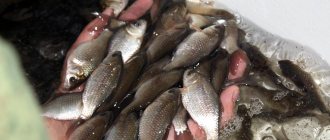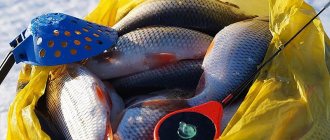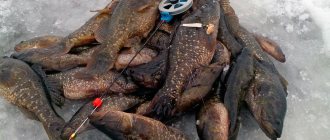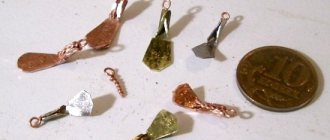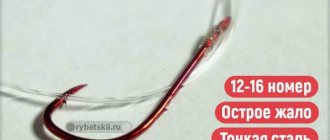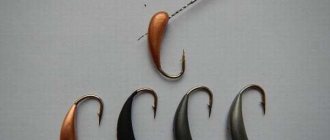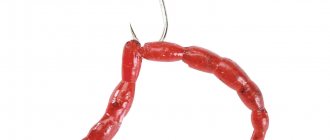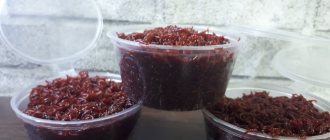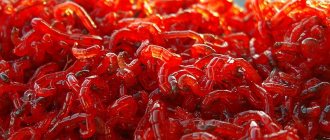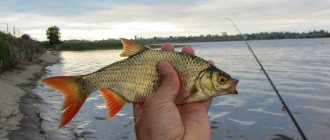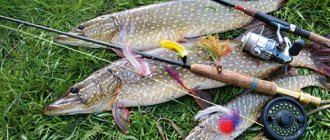Bloodworm is the best bait
This is a universal bait, any fish will accept it. It’s easy to get, it costs nothing, it doesn’t require any special tools, and there are dozens of ways to wash bloodworms in large quantities; you don’t even need to stock up in advance, you can always find it before fishing right on the spot. And the catch for bloodworms is the heaviest, because the fish is a predator by nature, and does not suffer from a lack of appetite.
Where to find bloodworms for fishing
There are several places where bloodworms can be found. The simplest and most reliable is to go to the store and purchase the required amount of bloodworms. However, this method significantly hits the pocket of the average fisherman. If you can buy a worm and maggot without hesitation and not worry about the cost, then bloodworms will cost more. Therefore, many people have thoughts about where to get bloodworms.
Bloodworms live in silted ponds, swamps and streams. If you are fishing on a river or lake with silt at the bottom, then in any case the bloodworm should be at the bottom. He lives right in the mud. Therefore, you will have to get it out with your own hands and wash the bloodworms on the shore.
As a rule, bloodworms are concentrated in the recesses. It does not lie in an even layer over the entire surface of the bottom. If you scoop up the sludge in several of these depressions, you will probably find a sufficient number of larvae. Soft areas where there is no vegetation, debris or stones are considered promising. Another important sign is swarms of mosquitoes above the surface of the reservoir. If you notice such a cluster of insects, then you are on the right track and most likely you will catch bloodworms.
In warm weather, bloodworms live shallow in the silt, just a couple of centimeters from its surface. In winter, it rolls down to a depth of 30 cm and even deeper.
Where are bloodworms obtained?
The bait loved by almost all fish is obtained very easily and at any time of the year. It is more common for a novice fisherman to buy it at the poultry market, but a more experienced fisherman can get it himself. The best place to wash bloodworms is fresh water with standing water or a quiet current and a muddy bottom. You need to lift a little sludge from the bottom with a bucket or a special scoop and wash it through a sieve or fine mesh. Collect the floating bloodworms and use them for bait.
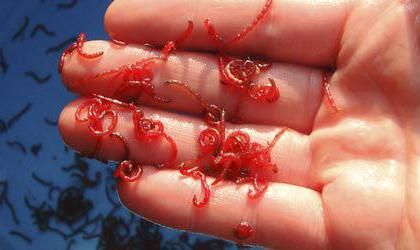
How to sort larvae
Bloodworms that are ready for use can be sorted into larger and smaller individuals. The small things will be used to feed the fish, and the large larvae will be used as bait on the hook. You will need a jar of water and a fine sieve. Before washing the bloodworms, place a sieve over the jar and unload the bloodworms, cleared of sludge, into it. We rinse it little by little with water. Small worms will go through the pores into the jar, while large ones will remain in the sieve.
If you are not going to use all the bait at once, you need to store it properly. If everything is done correctly, the larvae will last up to three weeks. Of course, you can freeze them, but in this case the bloodworms are only suitable for complementary feeding, and for bait it is better to take live larvae. This will only improve the quality of fishing.
How to put a bloodworm on a hook
Depending on the fishing conditions, there are a number of ways to attach bait. The specificity of the conditions includes the type of fish caught, its activity and size. The fish's bite differs in intensity, which, in turn, varies from the aggressiveness of the fish's feeding. Sometimes the fish immediately swallows the bait, in other cases it tries it by sucking on the bloodworm or sharply hitting it and thus knocking it off the hook. For each type of bite, there is a method of planting larvae, which we will introduce the reader to in the continuation of the conversation.
Standard method
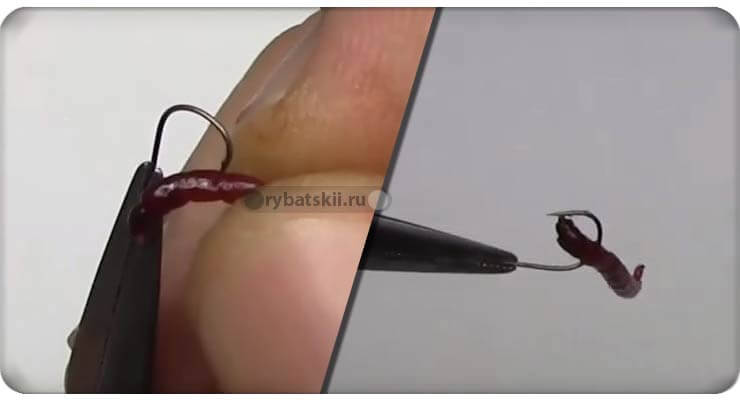
Standard method
With this technique of mounting a delicate bait, the bait is taken with the index finger and thumb. Next, the third segment of the larva from the head, which is clearly visible on the body of the worm, is carefully pierced with a point. The tip of the hook is pulled outward, and the larva itself is moved to the middle of the hook of the accessory. Thus, it is possible to bait not only a single specimen of even a small moth, but also a portion of bait from 2 to 5 larvae.
The method is suitable for actively taking fish and, in particular, fishing with a winter feeder. Basically, this technique is used to equip gear for catching small and medium-sized fish.
According to experienced anglers, baiting a bloodworm across is more effective, since there are fewer empty bites.
Head attachment
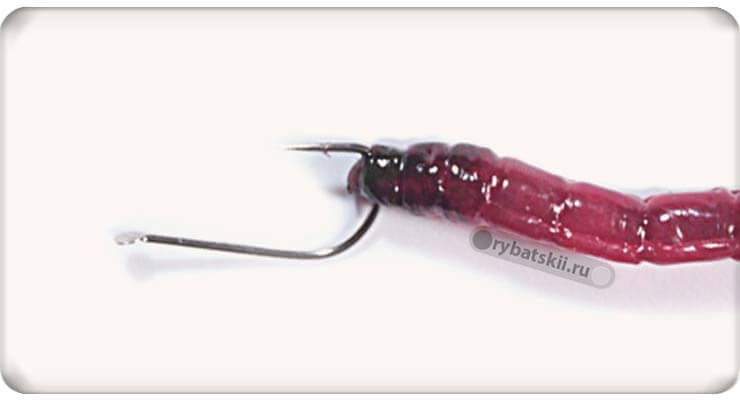
Head impaling
Taking a closer look at the red worm, it is easy to identify its head, which is dark, closer to black, with a clearly noticeable point at the end. Follow the following algorithm for mounting the larva by the head:
- The larva is gently pressed with two fingers of one hand, while its head will protrude above the holding index and thumb by 2–3 millimeters.
- The tip of the hook extends exactly in the middle of the ring of the larval body located below the head and extends outside the body of the worm.
Attaching the bloodworm to the head allows the larva to remain alive and active in its movements for a long time; it is harder for the fish to knock it off the hook, which increases the effectiveness of bites. Often perch and ruffe are caught this way, aggressively hitting rigs with bait .
Ring attachment method
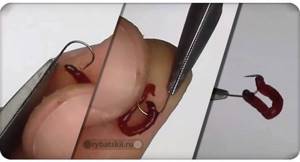
With a ring
Another popular and frequently used technique is the method of attaching a moth with a ring. The process will require some skill, which is quickly developed with a couple of trial attempts at the nozzle. The manipulation looks like this:
- The first segment is pushed onto the sting, under the head of the worm, bringing the tip out.
- The same operation is carried out with the tail of the worm, bending the body into a ring.
A correctly mounted bloodworm is on the hook rolled into a ring, which fully imitates the behavior of a worm in its natural conditions in the bottom layer of a reservoir, without arousing suspicion in the fish.
The technique is applicable for passive fish, when bites are barely noticeable, and their development turns into a sluggish and weakly flowing process with a blurred hooking moment. By baiting a bloodworm with a ring, they catch fish of the most varied types and sizes.
Stocking attachment
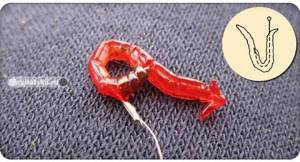
Stocking
Mounting a butterfly with a stocking refers to the formation of thin baits that allow you to catch cautious and capricious fish. This way you can catch roach, where even one copy of the larva brings positive results. The method algorithm is presented below:
- Using a hook, we prick the first ring from the head of the worm.
- Without pulling the tip of the hook out of the body of the moth, it is carefully pulled towards the tail of the bait.
- Without extending the hook a couple of segments to the tail of the worm, the tip is left in the body of the moth.
After installation is completed, the nozzle is carefully inspected for leaks. If the bloodworm is leaking, it needs to be replaced with a new worm, since otherwise, after just a minute of being in the water, the liquid will flow out and only a shell that is unattractive to fish will remain on the hook.
This method is suitable when there are a lot of empty bites.
Belt attachment
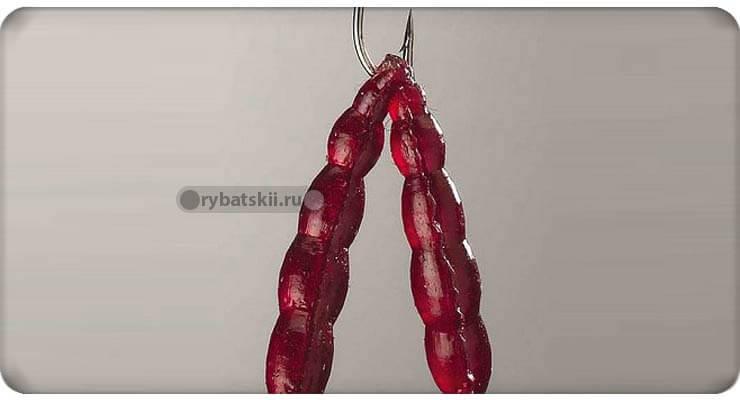
Belt attachment
The method of attaching the bloodworm to the hook using the belt method helps to delicately place the bloodworm on the hook. This method is intended for catching inactive and suspicious fish. Often crucian carp are caught in this way by mounting the bait. The belt mounting technique will require several preliminary training sessions. The nozzle process is carried out using the following manipulations:
- The worm is pricked with a sting exactly in the middle.
- Next, draw the hook towards the head inside the shell to the length of 2-3 segments and pull it out.
- After this, the bloodworm is moved to the middle of the hook shank, making sure that the head of the bloodworm is turned toward the top of the rig during this manipulation.
How to properly attach a bloodworm to a jig
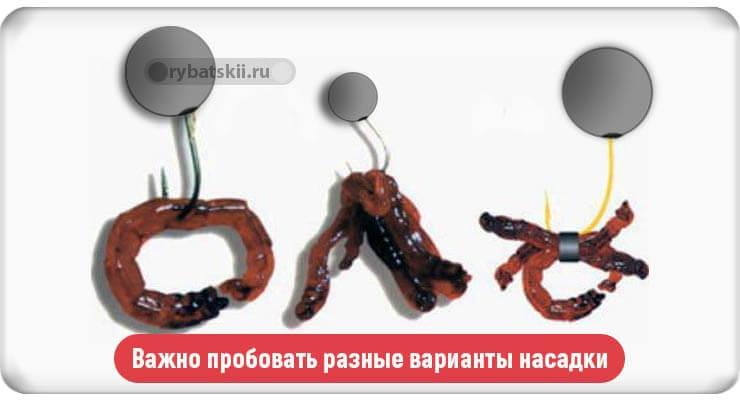
Different ways to attach bloodworms to a jig
Ice fishing in most cases is carried out using a jig. For fish that are cautious and not very active in winter, fishermen use small jigs. Even large bream can be caught on a tiny hook and sinker combination. Bloodworms are placed on jigs in any of the following ways, choosing it based on the intensity of the bite and the aggressiveness of the fish.
And also, depending on the shape and size of the jig, combine the attachment methods, for example, put two bloodworms using the attachment method behind the head or belt, and attach the latter with a ring or stocking. This technique will allow you to find an effective option for presenting bait. This will help you get a larger number of bites, and sometimes a more weighty trophy, cutting off annoying little things.
Catching bloodworms in winter
Bloodworms can be caught all year round. And winter fishing is no exception. Of course, in the summer there are a lot of bugs and worms that can lure fish. In winter the task becomes a little more difficult. You will have to look for muddy areas in shallow water or hit wormwood and get the mud from the bottom, where the bloodworms overwinter. There is a very simple way to wash bloodworms in winter; even a beginner can do it. It is enough to light a fire on the shore, scoop up the mud from the bottom with a bucket and place it next to the heat. Very soon the larvae will begin to float to the surface and can be collected. As you can see, it’s simply an ideal option: there’s no need to sift through dirty sludge, freeze in cold water, or pay for a portion of food at the market.
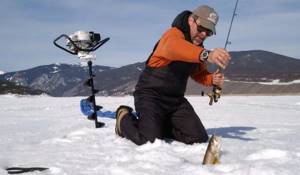
If you don’t need bloodworms urgently and there are no equipment nearby, there is another opportunity to wash bloodworms in winter with your own hands, and in large quantities. We take a piece of fish or meat, any scraps will do, wrap it in gauze or a mosquito net, attach a weight to it with a rope and lower it to the bottom. The next day you can take it out. Rest assured: there will be plenty of larvae on the bait. In addition, there may be many other living creatures here: various swimming beetles, water mites, leeches, shells. They can also be used as bait and diversify the winter fishing menu.
How to get bloodworms
The largest number of mosquito larvae in the natural environment can be found in the silt of lakes and ponds, abundantly overgrown with bottom vegetation. They are also found in flowing bodies of water. Having determined the habitat, it is easy to wash bait for fish yourself.
The easiest way to do this is to use a fine sieve in which the bottom silt is rinsed. The soil is carried away with the water, and the larvae remain on the sieve. They are easy to collect with a fine-mesh net. Getting bloodworms will not be an insurmountable problem if you use a fork with a long handle and a thin metal wire wound around the teeth. It is tied with horizontal lines at intervals of 6-7 centimeters. By raking the constructed device along the bottom of the reservoir, you can easily catch mosquito larvae.
To learn more:
Advantages of silicone predator baits
The third method of extraction is even simpler - the silt is scooped up with a bucket and placed near a hot fire. Feeling the warmth, the bloodworm will float to the surface from which it is collected with a net.
The slowest, but quite effective method of obtaining larvae is to lower pieces of meat or fish wrapped in a gauze bag and loaded with heavy cobblestones to the bottom of the reservoir. In about a day, the trap will have a lot of bait.
How to wash bloodworms is up to each hunter to decide for himself. And to separate small specimens from large ones, just put them in a fine sieve and lower them into a container of water. Large prey will remain on the mesh, and small fry will leak out along with the liquid.
Where to store
The bloodworm is well preserved. To transport and store it during fishing, it is convenient to use various boxes made of wood or foam, the so-called blood boxes. They can be purchased on the market or made independently.
If all of this bait is used during fishing, then no special storage containers are needed. It is enough to dry the food in the air for 20 minutes, spreading it on a piece of newspaper, and then transfer it to a blood dish or any box with small holes. It is advisable to line the bottom with a damp cloth.
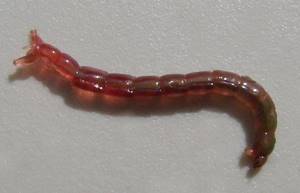
If you have learned how to wash a lot of bloodworms and have not used them completely for fishing, you need to provide special storage conditions. For longer storage, containers made of wood and foam are used. The bottom is lined with a damp cloth or foam rubber, a thin layer of larvae is placed on top and sent to the bottom shelf in the refrigerator. The bloodworm is suitable for use for about a week. Periodically you need to rinse the mass with clean water (but not chlorinated!), remove debris and dead bugs.
An equally successful invention is to store it in a jar of water. This method is suitable if you don’t know where to wash bloodworms in winter, but there is no way to buy them. The bloodworms are wrapped in gauze or fine mesh and dipped in water, which needs to be changed every two to three days and stored in a cool place. The larvae feel great for three weeks.
Bloodworm breeding
In order not to depend on the quality of the store product and weather conditions during extraction, mosquito larvae can be bred at home. To do this, you will need a plastic container or basin into which 2 cm thick sludge from the pond is placed. The soil is scalded with boiling water, cooled and filled with a mixture of cold water and nutritional yeast. The proportion should be 99:1 so that the sludge takes on the appearance of sour cream. It is important that the container with “seedlings” is stored at a temperature of 18-20°C. The future bloodworms are fed a second time two weeks later using dry yeast. If you pour too much food, the nursery will rot, so you need to be careful with the dosage (40 g per square meter is enough).
On the 16-18th day after laying, the larvae will mature and can be separated from the soil. It is necessary to place the dirt in portions on a sieve and rinse under running water. The sludge will go away, and the desired product will remain on the surface. It is quite suitable for further use, sale or storage. Used soil can be reused to raise new larvae.
Bloodworm breeding can be a good business and an additional way to increase your home budget if you learn how to raise queens to lay eggs. You need to wait until the larva turns into a pupa, then into an adult mosquito (after about 5 days). The females lay eggs and die. The cycle begins again.
For such production, at least two rooms are required (in one they contain adult mosquitoes and moistened sludge, in the second the larvae develop). From each square meter of production you can get about 15 grams of bloodworms. And the final amount of product will depend only on the total area of the containers.
poklev.com
Potato moth
The method of storing it in potato tubers has long been adopted. We take a large potato, cut off the top, remove some of the pulp inside and place the bloodworm larvae there. Add a little drunk tea and cover the top with the cut part, like a lid. Can be secured with toothpicks. You can store them this way for up to five days.
You already know how to wash bloodworms, but now you need to inform us that bloodworms are very sensitive to temperature changes, so it is better to store it in a container made of wood and foam. To prevent the larvae from sticking together, before going fishing, they are sprinkled with starch and placed in bloodworms or boxes with a wooden bottom and small holes.
How to store bloodworms at home and at the fishing site
Mosquito larvae are delicate baits that require careful handling. But if you follow a few simple rules, it’s easy to save them even over a long period of time. Depending on how long the bloodworms need to be stored, the “preservation” method is chosen.
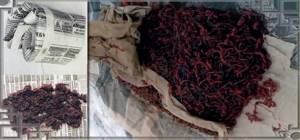
Apartment tricks
Mosquito larvae purchased in a store or caught with your own hands can be kept in your home for some time. First you need to sort them out, get rid of debris and white worms. Place the sorted bloodworms on a moistened sheet of newspaper. Then the paper is folded into an envelope.
To prevent the larvae from being pressed, rolls of soaked strips of newspaper are placed inside. The packaged bloodworms are sent to be stored in the refrigerator or placed between wooden window frames. Once every two days, the future fish food is sorted out, getting rid of dead fish. Old newspapers are thrown away and other sheets are taken. This method can be used to store larvae for 5-6 days.
If it becomes necessary to keep the bait for a longer period of time, they can be placed in a shallow baking tray and filled with a centimeter or two of water. In cold weather, send it to the balcony in a bucket, taking it indoors only during severe frosts.
The bait will last approximately the same amount of time in potatoes, from which the top is removed and the core is selected. To be safe, you can add used tea leaves inside. The larvae will not stick together if they are sprinkled with starch powder. You can close such a container with the saved top, securing it with a toothpick or a sharpened match.
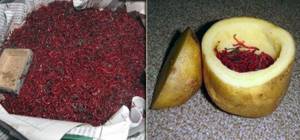
It is easy to store the bait in soaked burlap for up to ten days. A thin layer of bloodworms along with tea leaves are scattered on one half of the flap, covered with a damp newspaper sheet and the second part of the fabric is applied. The finished “pie” is stored in the refrigerator or other cool place. After 2-3 days, the burlap is rinsed and the larvae are dried.
For up to two weeks or more, the bait can be kept in an old nylon sock or stocking, hidden in a drain tank (provided that the water is not chlorinated) or other container. It’s a good idea to place the bait in a glass jar, half filled with clean snow, on top of which a layer of larvae is poured, then another layer of white crust. Place the container in the refrigerator and make sure that melt water does not collect in it.
Each fisherman decides for himself how to keep bloodworms alive at home. But if there is a need to preserve it for more than three months, it is advisable to freeze the larvae. First, the bait should be sorted, put into bags or boxes and sent to the refrigerator.
To learn more:
Fishing for a worm: where to dig and how to save
Coastal subtleties
When fishing, it is advisable to keep such a delicate bait wrapped in a soaked rag in a foam container. In severe frost, the box is hidden inside a sheepskin coat or sheepskin coat. Experienced trophy hunters deliberately freeze bait by scattering it near the holes. It is easier to attach such larvae to the tip of the hook, and they move away in the water.
In summer, the bait is kept in a metal can, with holes drilled in the lid for air, or wrapped in a damp rag in the wind (moistened with water if necessary). The tin should be hidden from hot sunlight.
Storing bloodworms while fishing and at home greatly simplifies the use of special cassette boxes (can be purchased at pet stores). You just need to change the water in them every day and wash the container with soap at least once a week. In such a container, the bait remains fresh for about a month.
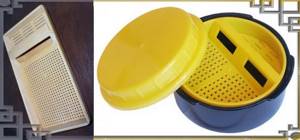
We buy correctly
Many fishermen claim that the best bait is bloodworm. There are many ways to wash bloodworms on your own. It's not difficult, but it requires some skill and extra time. If you don’t have enough patience, feel free to go to the market and choose there.
Carefully inspect the future bait. High-quality bloodworms are red in color, always clean, the skin is dense, without damage. Under no circumstances should you buy with a mixture of earth. Even if you are going to use the larvae right away, they are unlikely to make it to fishing. Often, unscrupulous sellers deliberately mix soil in order to dilute low-quality goods and sell half-dead larvae. An experienced fisherman will easily detect the substitution, but it is not difficult to deceive a beginner.
Place on the hook
There is no better bait than bloodworms. It is suitable for many fish species and is available all year round. In winter, they often use one or even half a bloodworm per hook. In summer, the bite is better and it is easier to get it, so the number of larvae for bait can be increased.
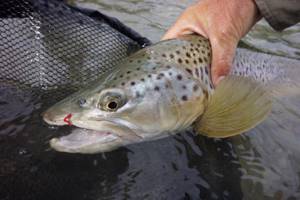
There are several ways to attach a hook:
- with a ring, piercing the tail and head alternately;
- under the heads;
- in a bunch, gathering several larvae together.
The first method allows you to attach the bait to the hook more compactly. It is not easy for the fish to pick it off and will have to swallow it whole, which is only to the benefit of the fisherman.
You need to hook it under the head very carefully. The larva is very delicate, and such bait is easy to damage.
Technique for planting bloodworms
Insect larvae are a rather delicate product, sometimes they are smeared directly on the fingers. To keep the bait intact on the hook and make it appetizing to the fish, you should attach it correctly. There are the following options for placing bait:
- Hanging fresh bloodworm.
- Dressing the larva across.
- Impaling with a stocking or ring.
- Engaging baits with a beam.
The first method is used when fishing for medium-sized perches. The nozzle is placed on the finger and pierced with your free hand near the head so that the bloodworm hangs from the hook tip in the form of a thread. There is no need to hide the point, since it does not interfere with the fish. A correctly hooked larva remains viable in water for 8-10 minutes, after which it is advisable to replace it.
When fishing for roach, the bait is hooked across the sting. To do this, the bait is pierced not near the head, but in the middle. In the water column, a bait placed in this way makes oscillatory movements with both ends, attracting hungry fish.
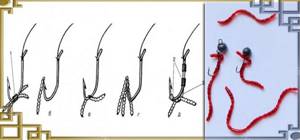
In its natural environment, the bloodworm curls up into a ring. In this position, the inhabitants of the underwater world find him. To make the bait on the hook look just as natural, it is taken by the back and pierced with a sting, forming a small ring. In a reservoir, such bait moves well, and it is more difficult for fish to pick it off.
The method of putting on a stocking is that the tip is inserted in the area of the head, but is not pushed out, but is pushed onto the sting with light turns until the end of the tail. The advantage of this method is that the fish will not be able to pull the bloodworm with impunity.
To learn more:
Takedo: are their baits as good as they advertise?
The technique of putting on larvae in a bunch is used in cases where bites from large individuals are expected. Several bloodworms are taken out of the bait storage container (for perch and roach 2-3 are enough, in the hope of catching bream you can use up to a dozen) and put them on the hook by the head. The advantage of this method is that a bunch of larvae release more juice and attract bottom inhabitants faster.
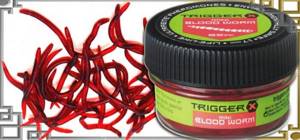
All in a bundle
The bloodworm attachment in a bunch is more suitable for fishing in the warm season. There is plenty of bite, the fish are more active, and there are practically no questions about how to catch bloodworms in the summer. If you can’t get it yourself, feel free to go to the market. The main thing is to choose fresh, without admixture of clay and soil.
A special bundle knitting device is sold in stores. With its help, bloodworms can be tied into a tube or in a bundle. They are secured to each other with silicone cambric, to which they cling to a hook. Bloodworm is a very fragile bait, and the cambric helps not damage the body of the bloodworm and prevents it from spreading in the water.
You can do without bundle elm by tying the larvae by hand with regular thread. The main thing is not to damage the bait, because fish react better to live and moving bloodworms.
The use of artificial bloodworms
Sometimes anglers have a hard time finding quality bloodworms in a pet store. Either there is none, or it is of low quality and is only suitable for complementary feeding, not for bait. If you don’t know how to wash bloodworms yourself, then artificial bloodworms made of silicone are suitable for fishing. In color and shape, it successfully imitates the real thing. In addition, the material was chosen well. Silicone is very light, soft, flexible and very similar to live bait.
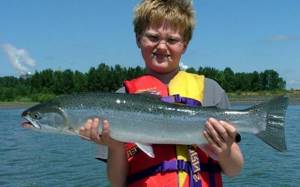
Not long ago, bloodworms made from edible rubber with an odor were released onto the market. A special flavor (attractant) is very attractive to fish, and in appearance it is almost impossible to distinguish it from the real thing.
Well, if you haven’t found this, you can make your own bait. Just take a red rubber balloon and cut it into small strips.
Features of fishing with bloodworms
The key to successful hunting for this bait is the correct choice of the right equipment. Depending on the time of fishing and the expected catch, the thickness of the leads should be 0.05-0.12 mm. Thin hooks number 20-28 are tied to them if a single larva is attached, and number 16 when fishing on a bunch. The float should submerge well, leaving only the antenna visible above the water surface.
No less useful tips would be:
- Bloodworms for fishing should only be taken fresh. High-quality bait has a bright red color, it glistens in the sun and moves actively. In stale embryos, the shade is not so pronounced, it is more faded.
- After each successful bite, the bait should be replaced.
- Since fresh bait is always slippery from moisture, you need to handle it gently and only with dry hands.
- The presence of only a mosquito larva on a hook does not always contribute to rich catches. It is advisable to plant the bait in a bunch or combine it with maggots.
To learn more:
Hitfish brand: new baits
Fishing in autumn
Autumn fishing has its charms. Despite the sunny days, in the evening the temperature gradually drops and the water cools down. The fish begin to prepare for winter: they gain fat and form schools. During this period, complementary feeding works more effectively. Autumn catches are impressive. It's time to change baits: the fish actively eats, so animals prefer vegetable baits. And bloodworm is now the main thing on the menu.
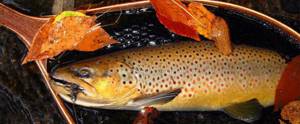
But in autumn the water becomes clearer, and the fish become cautious and suspicious. Therefore, light tackle, miniature hooks and compact baits are in use. And bloodworms are the best option. The fish, without feeling a catch, bites it perfectly. The small size of the bait is well received by the fish and does not alarm it. Therefore, information on how to wash bloodworms in the fall will be of interest to many. There are many ways that have been invented, here is one of the simple ones.
You will need several devices: one that scoops up silt from the bottom, for example a scoop with a long handle, a shovel wrapped in wire and mesh, a net with a hard rim, a bucket with many holes in the bottom and sides. Another is washed, or, for example, a sieve or grid with small holes, covered for convenience with a fine mosquito net. The third device is a bucket or tray with water. Although they are often washed in the pond itself.
So, you need to scoop up more sludge from the bottom, place it in a sieve and alternately lower and raise it in a tray or bucket of water many times. Gradually, the sludge and other debris will sink to the bottom, and bloodworms will remain in the sieve. It should be dried a little in the air and moved to a storage container.
Instead of a scoop, a tin liter can with holes all over the surface will do. Be sure to attach a long handle to it. It will be very useful in the cold season, when silt is scooped from the wormwood. Only a weight is attached to the can for immersion in water.
And one more important fact. In autumn, you need more high-calorie bait. Therefore, it is good to combine bloodworms with maggots or caster, corn or semolina. The fish's appetite increases in winter, and such bait will come in handy.
Bloodworm - as the best attachment
A universal bait that is used as bait and as an element of groundbait. In winter, bloodworms are often used as pure bait. A bloodworm is a mosquito larva. She lives in silt. But not every body of water can boast of such an inhabitant. Reservoirs in which bloodworms live en masse are well known in large quantities.
Bloodworm species
Bloodworms are distinguished: small in size, up to 1 cm long with a bright red body, which is called stern. It can be used as a bait, you just have to look for a small hook made of thin wire. It is mainly used during winter fishing.
Large, with a body length of up to 2.5 cm. The body can have a dark red, brown, and sometimes greenish tint. This bloodworm is the main bait. It can be used for fishing all year round.
The exception is the summer heat. At this time, the bloodworm dies too quickly.
When can you fish with bloodworms?
This bait is one of the top baits for fishing at any time of the year. There is one exception - the summer heat. During this period, no fish, except the smallest ones, react to bloodworms. The best time of year when bloodworms become the main bait for fishing is the end of the ice fishing period - early spring. At this time, all fish living in any body of water react to bloodworms. In late spring, bloodworms are used to catch predators and white fish, sometimes in combination with maggots. Bloodworms become more difficult to store, and the fish changes its taste preferences.
Summer fishing with bloodworms means catching small fish (bleak, small roach, small tench, crucian carp, ruffe). Large fish need other food. There are, of course, reservoirs in which bloodworms remain a favorite bait for large fish, but such reservoirs are in the minority. Bloodworms are poorly stored at this time.
Also interesting: Boyle: what is this
Fishing with bloodworms in the fall becomes more effective compared to summer. Large and medium-sized fish, both predators (perch and small pike perch) and peaceful fish (crucian carp, carp, tench, roach, etc.) begin to react normally to bloodworms. Before freeze-up and winter, bloodworms become the main bait for catching freshwater fish. Moreover, very heavy specimens of bream, carp, roach and other large fish are caught on this bait. Bloodworms are indispensable throughout the entire period of ice fishing.
What kind of fish can bite on bloodworms?
The answer to this question is simple - any, except: peaceful fish whose diet completely lacks food of animal origin - grass carp and silver carp; predatory fish for which bloodworms are too small a bait - large pike, large perch, pike perch and burbot. The small fish listed above react to bloodworms. Perch can also take a stationary bait. The rest of the fish usually grab the bloodworm at the moment of movement.
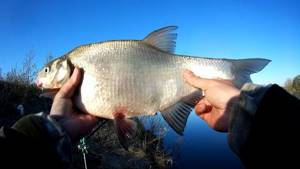
In winter, all peaceful fish are caught using bloodworms. Most often you come across bream, silver bream, bream, roach. Of the predatory fish, only small and medium-sized perch like bloodworms in winter.
In the spring before spawning, this bait is loved by bream, roach, crucian carp, tench, carp and many other fish. After spawning and until the very end of summer, bloodworms remain the main food for small fish only. In the fall, until the freeze-up, the bloodworm again becomes the main
How to store bloodworms
Fishermen know dozens of ways to store this bait. The most popular among them are:
- Mothworm. This container for storing bloodworms can be purchased at any fishing store. The bloodworms are poured into a damp cloth, wrapped, and then lowered into the bloodworm container. Store the container in the refrigerator on the bottom shelf. Can be stored without much loss in quality for up to three days.
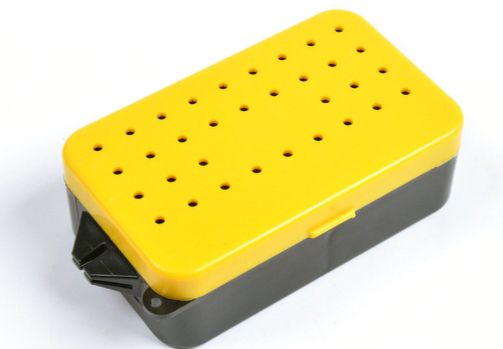
- Toilet cistern. The bloodworms are placed in a canvas bag, which is lowered into the toilet cistern. Bloodworms can be stored in this way for up to one week.
- In a tray with wet sand. Wet sand is poured into the cat litter tray, cold water is poured in so that it slightly covers the sand, and then bloodworms are poured into this mixture. If you change the water in the tray in time and remove dead larvae, then the bait can be stored in such a tray for more than a month. You can also store bloodworms in a glass jar with tea leaves, or in a potato tuber cut in half. Each method has its own advantages and disadvantages.
Category: Bait baits
